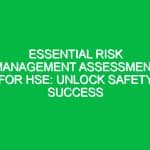Understanding Risk Identification Methods in HSE
Risk identification methods are critical tools used within the Health, Safety, and Environment (HSE) domain to identify potential Hazards, assess risks associated with those Hazards, and implement strategies to mitigate them. These methods form the foundation of effective Safety management systems, ensuring that organizations can proactively address risks before they lead to incidents or accidents. In an increasingly complex world, understanding and applying these methods is essential for protecting employees, the environment, and the organization itself.
Effective risk identification not only safeguards lives but also enhances organizational reputation and compliance with legal and regulatory requirements. This article delves into various risk identification methods, their significance in the HSE context, and how organizations can utilize them for Safety success.
Key Risk Identification Methods
There are several risk identification methods widely recognized in the HSE arena. Each method has its strengths, and selecting the appropriate one often depends on the specific context of the organization. Below are some of the most prevalent risk identification methods:
1. Hazard Identification (HAZID)
Hazard Identification (HAZID) is a qualitative method that focuses on identifying hazards in a systematic manner. It typically involves brainstorming sessions with multidisciplinary teams to discuss potential hazards associated with specific activities or processes. The primary objective is to generate a comprehensive list of hazards that could lead to accidents, injuries, or environmental damage.
For instance, during the construction of a new facility, a HAZID session might reveal risks such as falling objects, equipment malfunctions, or exposure to hazardous materials. By identifying these hazards early, organizations can implement preventive measures, such as safety barriers or Training programs, to mitigate risks.
2. Failure Mode and Effects Analysis (FMEA)
Failure Mode and Effects Analysis (FMEA) is a systematic approach used to evaluate potential failure modes within a system, process, or product. It assesses the impact of each failure mode on the overall system performance, allowing teams to prioritize risks based on their severity, occurrence, and detectability.
For example, in a manufacturing facility, an FMEA might identify a failure mode where a particular machine could malfunction, potentially causing product defects and safety hazards. By understanding these failure modes, organizations can implement design changes, enhance Maintenance protocols, or conduct training to minimize risks.
3. Job Safety Analysis (JSA)
Job Safety Analysis (JSA) focuses on identifying hazards associated with specific job tasks. It involves breaking down tasks into their individual steps, assessing potential hazards at each step, and implementing controls to mitigate identified risks. JSAs are particularly useful in environments where tasks are repetitive or complex.
Consider a scenario where a technician performs routine maintenance on heavy machinery. A JSA could help identify risks such as working near moving parts or the potential for electric shock. By addressing these risks through safety protocols and Personal Protective Equipment (PPE), organizations can enhance worker safety and reduce the likelihood of accidents.
4. What-If Analysis
What-If Analysis is a brainstorming technique used to explore potential risks by posing hypothetical “what-if” scenarios. This method encourages creativity and critical thinking, allowing teams to consider a wide range of possibilities that could lead to accidents or incidents.
For instance, in an oil and gas Operation, a What-If Analysis might ask questions like, “What if a pipeline leaks?” or “What if an employee fails to follow safety protocols?” By exploring these scenarios, organizations can identify gaps in their Safety Measures and develop contingency plans to address potential risks.
5. Risk Register
A Risk Register is a comprehensive tool that documents identified risks, their potential impacts, and the controls in place to mitigate those risks. It serves as a living document that organizations can update as new risks are identified or existing risks change.
For example, a construction company may maintain a Risk Register that tracks hazards related to site conditions, equipment, and employee health. By regularly reviewing and updating the register, the company can ensure that it remains vigilant against emerging risks and can implement timely interventions.
Benefits of Effective Risk Identification
Utilizing effective risk identification methods offers numerous Benefits to organizations within the HSE space:
- Proactive Risk Management: By identifying risks before they lead to incidents, organizations can take preventive actions, thus enhancing safety.
- Regulatory Compliance: Many industries are subject to Regulations that mandate risk assessments. Effective risk identification helps ensure compliance and avoid penalties.
- Enhanced Reputation: Organizations that prioritize safety often enjoy a better reputation among clients, customers, and the public, thereby gaining a competitive edge.
- Cost Savings: Preventing accidents and incidents reduces costs associated with worker compensation, legal fees, and property damage.
- Improved Employee Morale: A strong safety culture fosters a sense of security among employees, leading to higher morale and productivity.
Best Practices for Implementing Risk Identification Methods
Implementing risk identification methods effectively requires a structured approach. Here are some Best Practices to consider:
1. Engage Employees
Involving employees in the risk identification process is crucial. They often have firsthand knowledge of potential hazards and can provide valuable insights. Encourage open communication and promote a culture where employees feel comfortable reporting risks.
2. Use a Systematic Approach
Adopt a systematic approach to risk identification. This might involve using standardized templates, checklists, or software that facilitates the documentation and analysis of risks. Consistency ensures that no critical hazards are overlooked.
3. Regularly Review and Update Risk Assessments
Risk assessments should not be static. Regularly review and update them to reflect changes in processes, equipment, or regulations. This ongoing vigilance is vital to maintaining safety.
4. Provide Training
Ensure that employees receive training on risk identification methods. This equips them with the skills necessary to recognize hazards and understand the importance of proactive risk management.
5. Utilize Technology
Leverage technology to enhance risk identification efforts. Tools such as risk management software can streamline the process, making it easier to track and analyze risks efficiently.
Regulations and Standards Impacting Risk Identification
Various regulations and standards govern risk identification methods in the HSE context. Compliance with these regulations is crucial for organizations to operate legally and ethically:
1. Occupational Safety and Health Administration (OSHA)
In the United States, osha sets forth regulations that require employers to assess and mitigate workplace hazards. Compliance with OSHA standards often involves implementing risk identification methods to ensure employee safety.
2. ISO 45001
ISO 45001 is an international standard that provides a framework for Occupational Health and safety management systems. It emphasizes the importance of risk assessment and identification as part of a comprehensive safety strategy.
3. Environmental Protection Agency (EPA)
The EPA regulates environmental risks associated with industrial activities. Organizations must identify and manage risks to air, water, and soil quality, making risk identification methods essential for compliance.
Conclusion
In conclusion, effective risk identification methods are vital for achieving safety success in the HSE domain. By systematically identifying hazards, assessing risks, and implementing mitigation strategies, organizations can protect employees, the environment, and their bottom line. The benefits of these methods extend beyond compliance; they foster a culture of safety that enhances organizational reputation and worker morale.
As industries continue to evolve, so too must the approaches to risk identification. Organizations should remain vigilant, regularly updating their practices to adapt to new challenges and technologies. By prioritizing risk identification, companies not only ensure compliance with regulations but also promote a safer, healthier workplace for all.


